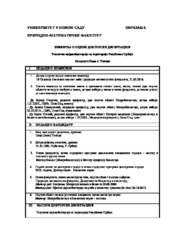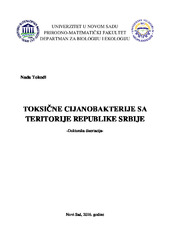Приказ основних података о дисертацији
Toksične cijanobakterije sa teritorije Republike Srbije
Toxic cyanobacteria from the territory of the Republic of Serbia
| dc.contributor.advisor | Svirčev, Zorica | |
| dc.contributor.other | Simeunović, Jelica | |
| dc.contributor.other | Svirčev, Zorica | |
| dc.contributor.other | Stokić, Edita | |
| dc.creator | Tokodi, Nada | |
| dc.date.accessioned | 2016-07-02T16:17:40Z | |
| dc.date.available | 2016-07-02T16:17:40Z | |
| dc.date.available | 2020-07-03T13:45:44Z | |
| dc.date.issued | 2016-06-28 | |
| dc.identifier.uri | https://nardus.mpn.gov.rs/handle/123456789/5647 | |
| dc.identifier.uri | http://www.cris.uns.ac.rs/DownloadFileServlet/Disertacija146132293653460.pdf?controlNumber=(BISIS)100706&fileName=146132293653460.pdf&id=5434&source=NaRDuS&language=sr | sr |
| dc.identifier.uri | http://www.cris.uns.ac.rs/record.jsf?recordId=100706&source=NaRDuS&language=sr | sr |
| dc.identifier.uri | http://www.cris.uns.ac.rs/DownloadFileServlet/IzvestajKomisije146304894836365.pdf?controlNumber=(BISIS)100706&fileName=146304894836365.pdf&id=5595&source=NaRDuS&language=sr | sr |
| dc.description.abstract | Ispitano je prisustvo toksičnih cijanobakterija u različitim ekosistemima sa teritorije Republike Srbije i analizirane su negativne posledice koje mogu da prouzrokuju ovi mikroorganizmi. Formirana je Baza podataka cijanobakterija u Srbiji koja prilaže veliki broj bitnih i korisnih informacija iz preko 70 literaturnih izvora o prostiranju i učestalosti pojave cijanobakterija i njihovih toksina u periodu od 130 godina, kao i njihovih efekata na živi svet u vodenim ekosistemima, ali i šire. Istraživana su 64 vodena ekosistema, uključujući reke, jezera, bare, kanale, ribnjake, akumulacije za navodnjavanje, akumulacije za snabdevanje vodom za piće i akumulacije sa drugom namenom, gde je najčešće cvetalo pet vrsta cijanobakterija i to: Microcystis aeruginosa, Aphanizomenon flos-aquae, Planktothrix agardhii, Microcystis flos-aquae i Planktothrix rubescens koje ujedno i šire svoj areal rasprostranjenja na teritoriji Republike Srbije. U brojnim vodenim telima detektovani su mikrocistini i to u visokim koncentracijama. Istraživanje vodenog ekosistema Ludoš sa teritorije Republike Srbije vršeno je da bi se ustanovilo prisustvo i uticaj cijanobakterija i cijanotoksina na druge biljne i životinjske organizme u prirodnim uslovima. Trofički status jezera Ludoš najčešće je eutrofan, a cvetanje cijanobakterija kontinuirano još od 1970. godine. Tokom 2011. i 2012. godine vrste Limnothrix redekei i Pseudanabaena limnetica nađene u cvetanju. Detektovano je i prisustvo mikrocistina/nodularina i saksitoksina u biomasi i vodi, a mikrocistini su detektovani i u tkivu vodenih biljaka (trske Phragmites communis, rogoza Typha latifolia i ljubičastog lokvanja Nymphaea elegans) i ribi (Carassius gibelio) iz jezera Ludoš. Histološkim pregledom tkiva ribe pronađene su naizraženije promene u jetri, bubrezima i škrgama, a primećene su i na crevima. Testiranjem bioloških lesnih pokorica sa teritorije Vojvodine nisu detektovani mikrocistini/nodularini, a nije detektovana ni toksičnost uzoraka. Pretpostavlja se da su koncentracije cijanotoksina ispod granica detekcije ili ih nema u testiranim biološkim lesnim pokoricama. Razvojem novih metoda i optimizacijom postojećih za detekciju cijanotoksina u biološkim lesnim pokoricama i drugim terestričnim ekosistemima potrebno je proveriti dobijene rezultate. Proučavanjem svojstva 84 soja cijanobakterija iz NSCCC, koji potiču iz terestričnih i vodenih ekosistema sa teritorije Republike Srbije, dobijena je intracelularna toksičnost u eksponencijalnoj i stacionarnoj fazi rasta, kao i ekstracelularna toksičnost kod jednog soja koji potiče sa terestričnog ekosistema. Dobijeni su i pozitivni rezultati na prisustvo mikrocistina, nodularina ili/i saksitoksina kod 34,1% terestričnih i 55,5% vodenih sojeva koji potiču sa teritorije Republike Srbije. Rezultati ukazuju na potencijalnu opasnost pojave ovih mikroorganizama i njihovih toksičnih metabolita u različitim ekosistemima sa teritorije Republike Srbije. Eksperimentalno je potvrđena akumulacija mikrocistina u račiću Daphnia pulex usled ishrane toksičnim sojem iz NSCCC, zbog čega upotreba ove vrste račića u izvođenju bioloških testova za testiranje prisustva cijanotoksina treba da se preispita. Štaviše, veliki broj jedinki dafnija (92,2%) koristio je istraživane sojeve iz NSCCC za ishranu, odnosno ishrana je bila moguća sa svim vodenim i sa gotovo 90% terestričnih sojeva, što može poslužiti kao osnov za dalja istraživanja prevencije cvetanja. S obzirom na mogućnost ishrane račića Daphnia sp. cijanobakterijama, kompleks ribnjaka sa teritorije Republike Srbije korišćen je za istraživanje potencijalnog načina prevencije pojave i cvetanja cijanobakterija u zavisnosti od pravovremenog unošenja pomenutog račića. Na osnovu koncentracije hlorofila a i trofičkog statusa, kvalitativne i kvantitativne analize cijanobakterija, toksičnosti vode i prisustva cijanotoksina mikrocistina/nodularina i saksitoksina, potvrđeno je smanjenje cvetanja cijanobakterija i drugih negativnih efekata u eksperimentalnim jezerima u odnosu na kontrolna. Ukoliko pak dođe do cvetanja i proizvodnje toksina ijanobakterija u vodenim ekosistemima, zbog ozbiljnost pojave i mogućih negativnih posledica po zdravlje ljudi, neohodno je uvesti postupke eliminacije ćelija cijanobakterija i njihovih toksina u praksu pri obradi otpadnih voda i prečišćavanja vode iz površinskih akumulacija u Republici Srbiji. | sr |
| dc.description.abstract | The presence of toxic cyanobacteria in different ecosystems from the territory of the Republic of Serbia was analyzed as well as the negative consequences that may be causeed by these microorganisms. Serbian Cyanobacterial Data Base was formed where great number of important and useful information from over 70 literary sources regarding the distribution and frequency of cyanobacteria and their toxins over a period of 130 years, as well as their effects on wildlife in aquatic ecosystems, and beyond was presented. The study consisted of 64 aquatic ecosystems, including rivers, lakes, ponds, canals, irrigation reservoirs, reservoirs for drinking water supply and reservoirs with other purpose, where five species of cyanobacteria Microcystis aeruginosa, Aphanizomenon flos-aquae, Planktothrix agardhii, Microcystis flosaquae and Planktothrix rubescens frequently bloomed, and also expanded their area of distribution on the territory of the Republic of Serbia. In many water bodies microcystins were detected in high concentrations. Research into aquatic ecosystem Ludoš, located on the territory of the Republic of Serbia, was performed in order to determine the presence and effect of cyanobacteria and cyanotoxins on other plant and animal organisms in natural conditions. Trophic status of the lake Ludoš was usually eutrophic, and cyanobacteria bloom is constant since 1970. During 2011 and 2012, the species Limnothrix redekei and Pseudanabaena limnetica were found in blooming. Presence of microcystins/nodularin and saxitoxin was detected in biomass and water, and microcystins were detected in tissues of aquatic plants (reed Phragmites communis, cattail Typha latifolia and royalblue waterlily Nymphaea elegans) and fish (Carassius gibelio) from the lake Ludoš. Histological examination of tissue showed most prominent changes in liver, kidney and gills, and alterations were also observed in the intestine. Testing of the biological loess crust from Vojvodina showed no presence of microcystins/nodularin and toxicity of samples was not detected as well. It is assumed that cyanotoxin concentrations were below detection limit or are absent from the tested biological loess crusts. The development of new methods and optimization of existing ones for detection of cyanotoxins in biological loess crustsand other terrestrial ecosystems is necessary in order to revise obtained results. Research of the properties from 84 strains of cyanobacteria from NSCCC originating from terrestrial and aquatic ecosystems from the territory of the Republic of Serbia, resulte d inintracellular toxicity in exponential and stationary growth phase, as well as extracellular toxicity of a strain originating from terrestrial ecosystems. The obtained results were positive for the presence of microcystins, nodularin and/or saxitoxin for 34.1% terrestrial and 55.5% aquatic strains originating from the territory of the Republic of Serbia. These results demonstrate the potential risk of occurrence of these microorganisms and their metabolites in different ecosystems from the territory of the Republic of Serbia. Accumulation of microcystins in shrimp Daphnia pulex after feeding with toxic strain from NSCCC was experimentally confirmed, indicating that the use of this species of shrimp in biological tests which determine the presence of cyanotoxins needs to be revisited. Moreover, a large number of Daphnia individuals (92.2%) used the investigated strains of NSCCC for food, and the feeding was possible with all the water strains and nearly 90% of terrestrial strains, which can serve as a basis for further research of bloom prevention. With regard to the possibility shrimp Daphnia sp. feeding with cyanobacteria, a complex of ponds from the territory of the Republic of Serbia was used to explore potential ways of prevention the occurrence and blooming of cyanobacteria, depending on the timely introduction of the aforementioned shrimp. Based on the concentrations of chlorophyll a and trophic status, qualitative and quantitative analysis of cyanobacteria, the toxicity of water and the presence of cyanotoxins microcystins/nodularin and saxitoxin, reduction in blooming cyanobacteria and other negative effects in the experimental lakes when compared to the control lakes was confirmed. If the blooming regardless occurres as well as production of cyanobacterial toxins in aquatic ecosystems, due to the seriousness of the phenomenon and the possible negative consequences for human health, it would be necessary to introduce procedures for the elimination of cells of cyanobacteria and their toxins into practice in waste water treatment and purification of water from surface reservoirs in the Republic of Serbia. | en |
| dc.language | sr (latin script) | |
| dc.publisher | Универзитет у Новом Саду, Природно-математички факултет | sr |
| dc.relation | info:eu-repo/grantAgreement/MESTD/Basic Research (BR or ON)/176020/RS// | |
| dc.rights | openAccess | en |
| dc.rights.uri | https://creativecommons.org/licenses/by-nd/4.0/ | |
| dc.source | Универзитет у Новом Саду | sr |
| dc.subject | Baza Podataka | sr |
| dc.subject | Blooms | en |
| dc.subject | Cijanotoksini | sr |
| dc.subject | Cvetanje | sr |
| dc.subject | Novosadska Kolekcija Kultura Cijanobakterija | sr |
| dc.subject | Republika Srbija | sr |
| dc.subject | Toksične Cijanobakterije | sr |
| dc.subject | Cyanotoxins | en |
| dc.subject | Data Base | en |
| dc.subject | Novi Sad Cyanobacterial Culture Collection | en |
| dc.subject | Republic of Serbia | en |
| dc.subject | Toxic Cyanobacteria | en |
| dc.title | Toksične cijanobakterije sa teritorije Republike Srbije | sr |
| dc.title | Toxic cyanobacteria from the territory of the Republic of Serbia | en |
| dc.type | doctoralThesis | en |
| dc.rights.license | BY-ND | |
| dcterms.abstract | Свирчев, Зорица; Стокић, Едита; Симеуновић, Јелица; Свирчев, Зорица; Токоди, Нада; Токсичне цијанобактерије са територије Републике Србије; Токсичне цијанобактерије са територије Републике Србије; | |
| dc.identifier.fulltext | https://nardus.mpn.gov.rs/bitstream/id/38768/Disertacija3546.pdf | |
| dc.identifier.fulltext | https://nardus.mpn.gov.rs/bitstream/id/38767/IzvestajKomisije3546.pdf | |
| dc.identifier.fulltext | http://nardus.mpn.gov.rs/bitstream/id/38767/IzvestajKomisije3546.pdf | |
| dc.identifier.fulltext | http://nardus.mpn.gov.rs/bitstream/id/38768/Disertacija3546.pdf | |
| dc.identifier.rcub | https://hdl.handle.net/21.15107/rcub_nardus_5647 |



